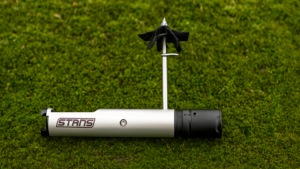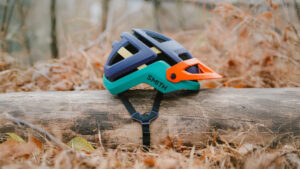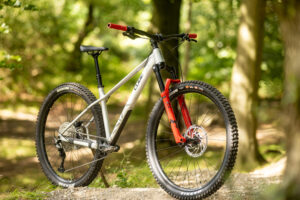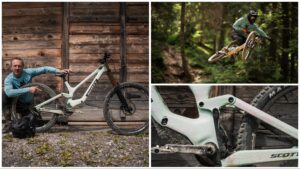Things are hotting up in the budget full-suspension category. First came the relaunched Calibre Bossnut, and now there's the updated Voodoo Canzo. And it's an impressive package.
The new Voodoo Canzo is a budget full-sus bargain, and I think it has better suspension than the Bossnut
Voodoo’s all new Canzo full-suspension trail bike isn’t perfect, but it’s a brilliant example of an affordable have-a-go-hero with future-proof upgrade features you won’t normally find at this price.

The basic Voodoo Canzo delivers ample cheap thrills.
Voodoo Canzo need to know
- Alloy frame 29in wheel affordable trail bike
- 140mm of RockShox suspension each end
- Excellent all round geometry
- 10 speed Shimano gears
- Clamped internal cable routing and UDH hanger
- Optional dropper on first batch of bikes
- Only three sizes: S, M, L
Voodoo’s Canzo has been around for years as a cheap and cheerful entry-level full-suspension bike, but this new model really steps up a level with an all-new design. So is it really ready to tackle full-on mountain biking? And how does it compare to obvious competitors like Calibre’s newly relaunched Bossnut? Time to find out.

Unlike the Bossnut, the shock tune on the Canzo doesn’t stifle the suspension.
Frame and geometry
This latest Canzo gets an all-new alloy frame including totally up-to-date features like a UDH dropout (the old Canzo used a 135mm QR rear end) and forged clamps for the internal control routing to stop it rattling and ensure a silent ride. The suspension is also a true four-bar design with a pivot on the chainstays and a vertically mounted shock, driven by a rocker link pivoting on the seat tube.

Clamped and sleeved internal cable routing ensures a blissfully silent ride.
The geometry has also been modernised, with exactly the 65º head angle claimed, and an effective seat angle of 77.2º at my 745mm saddle height. Reach is decent at 478mm on the large I tested, and the 435mm rear end is a happy medium between agility, stability, and climbing traction. The seat tube is relatively tall, but most riders will still be able to fit a 170mm dropper post if they buy a bike of the suitable length. BB height is an appropriate enough 339mm given the 140mm travel. That means the only real sizing miss is the lack of extra small or extra large frames.

Now with 29in wheels and modern geometry, the new Voodoo Canzo is in a different league to its predecessor.
Perhaps the biggest improvements to the Canzo are the addition of 29in wheels, which cover ground more efficiently and offer better stability, and the shorter seat tubes, giving you more room to move around the bike on technical trails.

Bolt-through back end adds stiffness, while the UDH hanger makes replacements easier to source.
Components
Speaking of range, Voodoo offers two Canzo models; the Pro at £1,800, and this base model at £1,350 (or £1400 as tested). The cheaper bike gets 10-speed Shimano Cues gears and twin-piston Shimano MT201 brakes, rather than 12-speed Shimano Deore and 4-piston MT420. The obvious difference between the two bikes when they were launched is now being sorted though so finding that extra £400 is no longer a big deal. That’s because while the first batch of bikes will come without a dropper for £1350, and you can add a 150mm Satori over-bar lever post for £50. However, after receiving my feedback, Voodoo has made a running change, and the second batch of bikes will come with a well-proven X-Fusion Manic dropper seat post with underbar lever fitted as standard. All for the same £1,400 price. That’s brilliant to hear.

The dropper post is a £50 upgrade on early bikes, but will come standard fit on later batches.
The RockShox 35R coil fork is very heavy at 1,840g, but something of a sleeper in terms of smooth performance. The RockShox Deluxe rear shock turns out to be a real win in terms of consistent control, too. Especially when other brand shocks, often seen at this price point, can be very rough in feel as well as unreliable. While it comes fitted with inner tubes, the rims and Maxxis tyres are tubeless-ready if you add valves and sealant. While they’re a relatively hard compound, with heavy wire rather than folding bead construction, those Forekaster tyres use a fast but usefully trustworthy tread pattern. In terms of finishing kit, the own brand 780mm bar, and 45mm stem, syncs well with the steering and the bolt-on grips are OK too.

RockShox supplies the heavy, coil-sprung 35 fork, but the action is beautifully supple and fluid.
Performance – how it rides
Historically, many affordable full-suspension bikes have been saddled with out-of-date geometry. Either because brands have just bought older open-mould frames from Far-Eastern factories, or out of the misguided belief that entry-level riders don’t want – or need – dialled handling. If anything though, new riders need a centralised riding stance and stable length / head angle more than anyone else.

At over 16kg, the Voodoo Canzo is not the spriteliest climber, but it’ll plod up at a steady pace with a comfortable riding position.
Climbing
Top marks to Voodoo then, for giving the Canzo totally on-point geometry that keeps the front end calm and controlled in steep and/or slippery conditions. However, it’s not such a downhill-specific, wheelbarrow-vibe, that climbs are a wobbly mess. Which means it hustles also cross-country super well. The seat angle kept the rear tyre biting on steep climbs without having to stick the saddle tip in my bum. Make sure you get the dropper post option fitted if you’re buying a bike from the first batch, though. Using the brass washer-smoothed seat release for lowering the saddle does work, but it’s a lot easier to just have a lever on the bars that’ll do it instantly.

Chuck it down a descent and the Canzo is fun and rewarding, with suspension that encourages the hooligan element.
Descending
With the saddle dropped, I could really appreciate, not just the sorted geometry of the Canzo, but also the excellent suspension spec. The fact that the rear end is smooth, without any obvious interruption to traction or comfort, and that it carries speed from pedalling or braking isn’t a surprise. The chainstay-pivoting ‘Horst Link’ layout of the Canzo has been a recipe for smooth neutrality since the Turner bikes of the early 1990s. However, compared to its obvious competitor at this price point – the Calibre Bossnut – Voodoo has clearly opted for a more open damping tune on the RockShox shock. That leaves the back end free and easy to move in response to lumps and bumps of all shapes, sizes and speeds. There’s enough bounce-back control from the simple rebound damping to keep the tyre gripping, rather than kicking up out of contact. As a result I loved how the Voodoo burbled fluidly over roots and rocks for traction through turns, down braking bumps and up climbs, but still didn’t freak out when I slapped it into a big block or landing.

Features like the clamped cables and silent ride make a big positive impact on the riding experience.
With no air seals to worry about, the coil-sprung RockShox 35 fork is outrageously smooth too, genuinely matching forks with four figure price tags for initial grip and comfort. While it weighs a ton, the steel 35mm legs also give a very accurate ride, with no choke coming from structural flex or internal slider binding. That meant I was still pushing the Voodoo hard several minutes into rough descents, when I’d normally have expected my hands and arms to start blowing up after the first few seconds of proper hammer. Riders of 90kg and over – or lighter riders who land hard – will also appreciate the extra spring support of the progressive coil for the last 40mm of travel. Unfortunately, if you’re not that heavy or sendy, you’ll struggle to push the fork past 100mm of travel. As it’s not an air-sprung fork, there’s no easy way to adjust that either, although there is an air spring upgrade available if you hunt around.
While it’s not a suspension feature, the bolt-in cable clamps are backed up with internal foam sleeves on the lines themselves to keep the Canzo super quiet, even on the roughest trails. It’s only a small detail, but a real subconscious boost to how controlled, calm and settled the bike feels as a whole.

Integrated chainstay protection is a feature usually found on much pricier models.
On the other hand, the numb feel and resin pads of the basic Shimano brakes mean power and control drop off rapidly in the damp despite being bearable in the dry. They’ve still got more feel and better reliability than most brakes you’ll find at this price though, and a switch to a 200mm front rotor would unlock 20% more stopping power for around £20. Once the original pads have worn out, sintered or hybrid brake pads will improve all-weather performance noticeably. The unbranded bottom bracket and hub bearings will need monitoring if you’re rain-riding or washing the bike a lot, compared to branded Shimano equivalents like those on the Calibre. The performance of the Shimano Cues LinkGlide gears themselves is a revelation, both in terms of light-trigger-touch and accurate shifts across the regular ratios of the 11-48 tooth block. The largely steel construction makes it tough in terms of wear, and more robust defending against wallops from trailside rocks and sticks too.

Voodoo has done a fantastic job of making a mountain bike that’s fun and rewarding to ride, at a price that within reach of most.
All that Shimano steel, plus wire bead tyres, a fork that weighs almost the same as RockShox Boxxer DH fork, and the solidly built frame, all adds up. On the scales, my large Canzo test bike weighed in at 16.7kg. Again that’s a bonus when it comes to feeling grounded and not getting thrown around. But there’s no escaping the inertia implications of that weight when it comes to acceleration or more dynamic moves. At least the Forekaster tyres make achieving and sustaining a reasonable speed easier than I feared, and the supple suspension flatters their grip in return. Plus, comparing rivals, the Bossnut is only 50g lighter, even with an air-sprung fork.
Verdict
There are bound to be compromises in spec, weight, and therefore performance when designers are trying to build a bike for an affordable price. The Voodoo Canzo doesn’t seem to care about compromises though, as it’s still bursting with everything you need for the engagement, entertainment and sheer idiot joy of arsing about in the woods on a push bike. Yes, it weighs a ton, but the riding position and handling are totally on-point for pedalling up stuff and then goofing back down. Tuning is minimal, and light riders won’t get full travel, but the suspension still punches way above the level you’d expect, allowing me to be reckless without regretting it. The gears are accurate and super tough, the brakes are better than most you’ll find at this price, and now you even get a dropper post. Neat, quiet, internal routing, a bombproof chassis, and UDH dropouts mean the Canzo is well worth upgrading as you grow into your riding. Or you could just invest in the Pro version now and get significantly better kit as standard.
















